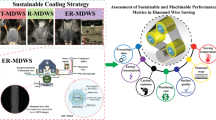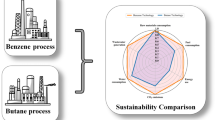Abstract
Manufacturing processes are performed to convert raw materials into products. To do this, natural resources are consumed and emissions are generated with potential for adverse environmental impacts. To obtain a productive system with fewer negative impacts on the environment, green manufacturing (GM) was used in this work, in which the environmental performance of an aluminum pipe machining was studied through the application of an integrated approach based on life cycle assessment (LCA) and eco-efficiency indicators. The proposed framework uses the unit process life cycle inventory (UPLCI) methodology followed by the eco-efficiency assessment to support decision-making in four levels: “win–win,” “lose-lose,” and two trade-offs reference-situations. The results contributed to the identification of the electricity and cutting fluid consumptions as the main life cycle hotspots to be minimized. Through a sensitivity analysis, future manufacturing scenarios were proposed to reduce the life cycle impacts based on eco-efficiency assessments. A “win–win” situation was found for the scenario that duplicates the number of parts manufactured at each production cycle, increasing from three to six machined parts per cycle, and reducing by 25% the volume of raw material to be machined. All of these enabled reductions in the life cycle impacts by up to 16.47% and has increased eco-efficiency by up to 23.55%. Finally, the integrated approach for LCA and eco-efficiency assessment can be used as an easy way to advance sustainability scenarios in manufacturing systems.












Similar content being viewed by others
Availability of data and materials
The authors confirm that the data supporting the findings of this study are available within the article.
Code availability
Not applicable.
Abbreviations
- CC :
-
Climate change
- CFused :
-
Volume of dirty cutting fluid generated by the process (in liters)
- Ee :
-
Eco-efficiency index, in units of manufactured product per unit of environmental impact
- Ee_baseline :
-
Eco-efficiency calculated with Eq. (3) for the baseline scenario
- FC :
-
Freshwater consumption
- FD :
-
Fossil depletion
- FEc :
-
Freshwater ecotoxicity
- FEu :
-
Freshwater eutrophication
- GM :
-
Green manufacturing
- HTc :
-
Human toxicity, cancer
- HTnc :
-
Human toxicity, non-cancer
- LCA :
-
Life cycle assessment
- LCT :
-
Life cycle thinking
- MD :
-
Metal depletion
- MP :
-
Fine particulate matter formation
- nc :
-
Number of cycles performed between a replacement and other (in units)
- np :
-
Amount of parts machined by the tool (in units)
- np :
-
Total amount of manufactured parts in one working day, in units
- PEI :
-
Potential environmental impacts depending on the impact category assessed, which can be expressed in kg CO2-eq., kg PM2,5-eq., kg oil-eq., m3, kg 1,4DB-eq., kg P-eq., kg Cu-eq., or kg SO2-eq., according to the impact category under investigation
- Relative Ee:
-
Eco-efficiency results in percentage units
- ƩTool:
-
Amount of tools consumed per part
- TA:
-
Terrestrial acidification
- TE:
-
Terrestrial ecotoxicity
- ToolZ:
-
Amount of tools used for machining (in units)
- UPLCI:
-
Life cycle inventory
- LCT:
-
Life cycle thinking
- volCFrep:
-
Volume of cutting fluid replaced (in liters)
References
Dolgui A, Ivanov D, Sokolov B (2020) Reconfigurable supply chain: the X-network. Int J Prod Res 58(13):4138–4163. https://doi.org/10.1080/00207543.2020.1774679
Garetti M, Taisch M (2012) Sustainable manufacturing: trends and research challenges. Prod Plan Control 23:83–104. https://doi.org/10.1080/09537287.2011.591619
Silva DAL, Silva EJ, Ometto AR (2016) Green manufacturing: uma análise da produção científica e de tendências para o futuro. Production 26(3):642–655. https://doi.org/10.1590/0103-6513.032513
Dornfeld D, Yuan C, Diaz N, Zhang T, Vijayaraghavan A (2013) Introduction to green manufacturing. In: Dornfeld D (ed) Green manufacturing: fundamentals and applications. 1ª ed. Berkeley, Springer, cap. 1, pp 1–23. https://doi.org/10.1007/978-1-4419-6016-0_1
Duflou JR, Sutherland JW, Dornfeld D, Herrmann C, Jeswiet J, Kara S, Hauschild M, Kellens K (2012) Towards energy and resource efficient manufacturing: a processes and systems approach. CIRP Ann Manuf Technol 61(2):587–609
Gutowkski TG, Allwood JM, Herrmann C, Sahni S (2013) A global assessment of manufacturing: economic development, energy use, carbon emissions, and the potential for energy efficiency and materials recycling. Annu Rev Environ Resour 38:81–106. https://doi.org/10.1146/annurev-environ-041112-110510
Sangwan KS, Mittal VK (2015) A bibliometric analysis of green manufacturing and similar frameworks. Manag Environ Qual 26(4):566–587. https://doi.org/10.1108/MEQ-02-2014-0020
Silva DAL, Firmino AS, Ferro FS, Christoforo AL, Leite FR, Lahr FAR, Kellens K (2020) Life cycle assessment of a hot-pressing machine to manufacture particleboards: hotspots, environmental indicators, and solutions. Int J Life Cycle Assess 25:1059–1077. https://doi.org/10.1007/s11367-020-01755-3
Oliveira JAD, Silva DAL, Puglieri FN, Saavedra YMB (2021) Introduction to life cycle engineering and management (LCEM). In: Life cycle engineering and management of products, Springer, Cham, pp 1–12. https://doi.org/10.1007/978-3-030-78044-9_1
Jiang Q, Liu Z, Li T, Cong W, Zhang HC (2019) Emergy-based life-cycle assessment (Em-LCA) for sustainability assessment: a case study of laser additive manufacturing versus CNC machining. Int J Adv Manuf Technol 102:4109–4120. https://doi.org/10.1007/s00170-019-03486-8
DeBoer B, Nguyen N, Diba F, Hosseini A (2021) Additive, subtractive, and formative manufacturing of metal components: a life cycle assessment comparison. Int J Adv Manuf Technol 115:413–432. https://doi.org/10.1007/s00170-021-07173-5
Filleti RAP, Silva DAL, Silva EJ, Ometto AR (2017) Productive and environmental performance indicators analysis by a combined LCA hybrid model and real-time manufacturing process monitoring: a grinding unit process application. J Clean Prod 161:510–523. https://doi.org/10.1016/j.jclepro.2017.05.158
Dornfeld D (2014) Moving towards green and sustainable manufacturing. Int J of Precis Eng and Manuf-Green Tech 1:63–66. https://doi.org/10.1007/s40684-014-0010-7
Soares LA, Firmino AS, Oliveira JA, Silva DAL, Saavedra YMB, Moris VAS (2022) Comparative LCA of automotive gear hobbing processes with flood lubrication and MQL. The International Journal of Advanced Manufacturing Technology 119:1071–1090. https://doi.org/10.1007/s00170-021-08331-5
Gupta MK, Song QH, Liu ZQ, Pruncu CI, Mia M, Singh G, Lozano JA, Carou D, Khan AM, Jamil M, Pimenov DY (2020) Machining characteristics based life cycle assessment in eco-benign turning of pure titanium alloy. J Clean Prod 251:1–14. https://doi.org/10.1016/j.jclepro.2019.119598
Kellens K, Dewulf W, Overcash M, Hauschild M, Duflou JR (2012a) Methodology for systematic analysis and improvement of manufacturing unit process life cycle inventory (UPLCI), part 1: Methodology description. Int J Life Cycle Assess 17:69–78. https://doi.org/10.1007/s11367-011-0340-4
Kellens K, Dewulf W, Overcash M, Hauschild M, Duflou JR (2012b) Methodology for systematic analysis and improvement of manufacturing unit process life cycle inventory (UPLCI), part 2: Case studies. Int J Life Cycle Assess 17:242–251. https://doi.org/10.1007/s11367-011-0352-0
Liu F, Yin J, Cao H, HE Y (2005) Investigations and practices on green manufacturing in machining systems. J Cent South Univ Technol 12:18–24. https://doi.org/10.1007/s11771-005-0004-2
Dahmus JB, Gutowski TG (2004) An environmental analysis of machining. Proceedings of International Mechanical Engineering Congress and RD&D Expo, Anaheim, California, pp 643–652. https://doi.org/10.1115/IMECE2004-62600
Belhadj I, Hammadi M, Aifaoui N (2021) Parallel disassembly approach with recycling rate calculation of industrial products. Int J Adv Manuf Technol 113:2969–2984. https://doi.org/10.1007/s00170-021-06830-z
Delpla V, Kenné JP, Hof LA (2022) Circular manufacturing 4.0: towards internet of things embedded closed-loop supply chains. Int J Adv Manuf Technol 118:3241–3264. https://doi.org/10.1007/s00170-021-08058-3
Lieder M, Asif FMA, Rashid A, Mihelič A, Kotnik S (2017) Towards circular economy implementation in manufacturing systems using a multi-method simulation approach to link design and business strategy. Int J Adv Manuf Technol 93:1953–1970. https://doi.org/10.1007/s00170-017-0610-9
Araujo JB, Oliveira JFG (2012) Towards a balanced scoreboard for assessing manufacturing processes sustainability. Int J Bus Perform Manag 13:198–221. https://doi.org/10.1504/IJBPM.2012.046201
Zendoia J, Woy U, Ridgway N, Pajula T, Unamuno G, Olaizola A, Fysikopoulos A, Krain R (2014) A specific method for the life cycle inventory of machine tools and its demonstration with two manufacturing case studies. J Clean Prod 78:139–151. https://doi.org/10.1016/j.jclepro.2014.05.012
Silva DAL, de Oliveira JA, Filleti RAP, de Oliveira JFG, da Silva E, Ometto AR (2018) Life Cycle Assessment in automotive sector: A case study for engine valves towards cleaner production. J Clean Prod 184:286–300. https://doi.org/10.1016/j.jclepro.2018.02.252
Linke B, Overcash M (2012) Life cycle analysis of grinding. In: Dornfeld DA, Linke BS (eds) Leveraging technology for a sustainable world. Springer, Berkeley, pp 293–298
Leme Júnior RDN, Nunes AO, Costa LBM, Silva DAL (2018) Creating value with less impact: lean, green and eco-efficiency in a metalworking industry towards a cleaner production. J Clean Prod 196:517–534. https://doi.org/10.1016/j.jclepro.2018.06.064
Abreu MF, Alves AC, Moreira F (2017) Lean-Green models for eco-efficient and sustainable production. Energy 137:846–853. https://doi.org/10.1016/j.energy.2017.04.016
Alves A, Moreira F, Abreu F, Colombo C (2016) Sustainability, Lean and Eco-efficiency Symbioses. In: Peris-Ortiz M, Ferreira J, Farinha L, Fernandes N (eds) Multiple Helix Ecosystems for sustainable competitiveness. Innovation, technology, and knowledge management. Springer, Cham, pp 91–12. https://doi.org/10.1007/978-3-319-29677-7_7
Leite FR, Antunes MLR, Silva DAL, Rangel EC, Cruz NC (2021) An ecodesign method application at the experimental stage of materials construction development: a case study in the production of mortar made with ornamental rock wastes. Constr Build Mater 293:1–6. https://doi.org/10.1016/j.conbuildmat.2021.123505
Thorn MJ, Kraus JL, Parker DR (2011) Life-cycle assessment as a sustainability management tool: strengths, weaknesses, and other considerations. Environ Qual Manag 20:1–10. https://doi.org/10.1002/tqem.20285
International Organization for Standardization (2012) ISO 14045: Environmental management — Eco-efficiency assessment of product systems — Principles, requirements and guidelines. ISO, Geneva
Salem A, Hopkins C, Imad M, Hegab H, Darras B, Kishawy HA (2020) Environmental analysis of sustainable and traditional cooling and lubrication strategies during machining processes. Sustainability 12:1–22. https://doi.org/10.3390/su12208462
International Organization for Standardization (2006a) ISO 14040. Environmental management - life cycle assessment - principles and framework. ISO, Geneva.
International Organization for Standardization (2006) ISO 14044: Environmental management - life cycle assessment - requirements and guidelines. ISO, Geneva
Shin SJ, Suh SH, Stroud I, Yoon SC (2017) Process-oriented Life Cycle Assessment framework for environmentally conscious manufacturing. J Intell Manuf 28:1481–1499. https://doi.org/10.1007/s10845-015-1062-4
Lonca G, Muggéo R, Imbeault-Tétreault H, Bernandr S, Margni M (2018) Does material circularity rhyme with environmental efficiency? Case studies on used tires. J Clean Prod 183:424–435. https://doi.org/10.1016/j.jclepro.2018.02.108
Uemura Silva V, Nascimento MF, Resende Oliveira P, Panzera TH, Rezende MO, Silva DAL, Aquino VBM, Lahr FAR, Christoforo AL (2018) Circular vs. linear economy of building materials: A case study for particleboards made of recycled wood and biopolymer vs. conventional particleboards. Constr Build Mater 285:1–17. https://doi.org/10.1016/J.CONBUILDMAT.2021.122906
Funding
This research is financially supported by the National Council for Scientific and Technological Development (CNPq—grant numbers 302722/2019–0 and 406017/2018–2). José Augusto de Oliveira thanks to Sao Paulo Research Foundation (FAPESP) grant number 2020/11874–5.
Author information
Authors and Affiliations
Contributions
Alessandro Silveira Firmino: investigation, conceptualization, methodology, writing original draft, experiments, and data analysis. Erica Kushihara Akim: review and prepare the images and references. José Augusto de Oliveira: review, data analysis, supervision, and validation. Diogo Aparecido Lopes Silva: review, data analysis, supervision, and validation.
Corresponding author
Ethics declarations
Ethics approval
All authors have previously approved this paper and judged that there is no ethical infringement.
Consent to participate
All authors in this article have informed consent to participate in this study.
Consent for publication
All authors agree to publish this article in The International Journal of Advanced Manufacturing Technology.
Competing interests
The authors declare no competing interests.
Additional information
Publisher's Note
Springer Nature remains neutral with regard to jurisdictional claims in published maps and institutional affiliations.
Rights and permissions
About this article
Cite this article
Firmino, A.S., Akim, E.K., de Oliveira, J.A. et al. Green machining of aluminum pipes: an integrated approach for eco-efficiency and life cycle assessment in manufacturing systems. Int J Adv Manuf Technol 121, 6225–6241 (2022). https://doi.org/10.1007/s00170-022-09737-5
Received:
Accepted:
Published:
Issue Date:
DOI: https://doi.org/10.1007/s00170-022-09737-5




